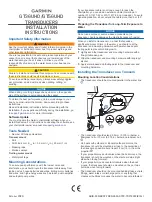
VHF OUTPUT RF METERING & AGC CIRCUIT BOARD
PUB96-33 rev 1: May 16, 1997
33-1
RF Output Metering 20B1299G3
).
.
er
carriers.
1
kW
this
Contents:
Sec
Topic
Page
1
RF
Metering
&
AGC
Board
Description
1
2
RF
Metering
Board
Test
and
Calibration
3
RF
Metering
&
AGC
Board
20B1299G3:
Figures
1
and
2.
This
board
serves
several
functions:
AGC,
VSWR
supervision,
forward
&
reflected
power
metering,
and
telemetry.
Except
for
their
functions
and
input
names,
metering
boards
have
identical
RF
detectors.
For
this
reason,
Detector
#1
for
"Forward"
will
be
described,
and
#2
for
"Reflected"
will
be
referenced
by
its
component
numbers
inside
parentheses
(
RF
Detectors:
The
#1
Forward
(#2
Reflected)
RF
power
sample
is
applied
to
J1
(J2)
and
is
terminated
by
R2
(R4).
A
small
amount
of
forward
bias
is
applied
to
CR1
(CR2)
via
R1
and
R5
(R3,
R6)
to
overcome
the
threshold
voltage
of
the
diode
and
enhance
its
detection
linearity
at
low
signal
levels.
The
opposing
connection
of
CR1
(CR2)
diode
junction
and
Q1
(Q2)
emitter
‐
base
junction
provides
temperature
compensation
Q1
(Q2)
buffer
amplifier
provides
a
low
impedance
source
to
drive
the
trap
C3,
C4,
and
L1
(C5,
C6,
L2),
through
R9
(R10).
This
trap
is
broadly
resonant
to
4.3
MHz,
and
significantly
attenuates
3.58
MHz
NTSC
color
subcarrier
as
well
as
any
4.5
MHz
intercarrier
that
may
be
generated
in
CR1
or
CR2
due
to
the
presence
of
visual
and
aural
RF
signals
together
in
the
system.
Removal
of
these
subcarrier
components
before
the
signal
is
peak
detected,
enables
the
circuit
to
be
responsive
to
sync
peak
pow
only
(for
visual)
or
just
CW
(aural)
power,
and
relatively
immune
to
undesired
CR3
(CR4)
is
a
peak
detector
with
a
time
constant
set
by
C7
and
R11
(C8,
R12).
The
signal
from
this
peak
detector
is
fed
to
op
‐
amp
U1
(U2)
pin
5.
The
gain
of
this
stage
is
2x
(4x),
and
its
output
on
pin
7
feeds
telemetry
and
metering
signals
to
the
outside
world.
In
the
board
used
as
Prefix
5A
in
the
transmitter,
pin
7
also
feeds
voltages
for
AGC
(VSWR
supervision)
to
the
pin
3
second
half
of
U1
(U2).
These
op
‐
amps
are
used
in
the
main
AGC
and
VSWR
functions
of
the
transmitter.
U1
(U2)
output
pin
7
zero
‐
offset
voltage
is
controlled
by
R18
(R20).
This
pot
should
be
set
with
no
RF
input,
so
that
while
you
watch
the
voltage
on
TP1
(TP2)
as
you
are
setting
the
pot,
you
will
observe
the
decrease
of
the
voltage
towards
zero.
When
it
ceases
decreasing,
stop
adjusting.
Expect
about
20
mV
offset
voltage
when
the
op
‐
amp
output
is
almost
touching
ground.
If
the
pot
is
turned
beyond
point,
the
output
stage
of
the
op
‐
amp
will
be
driven
into
saturation
thus
unable
to
respond
to
low
power
levels.




































